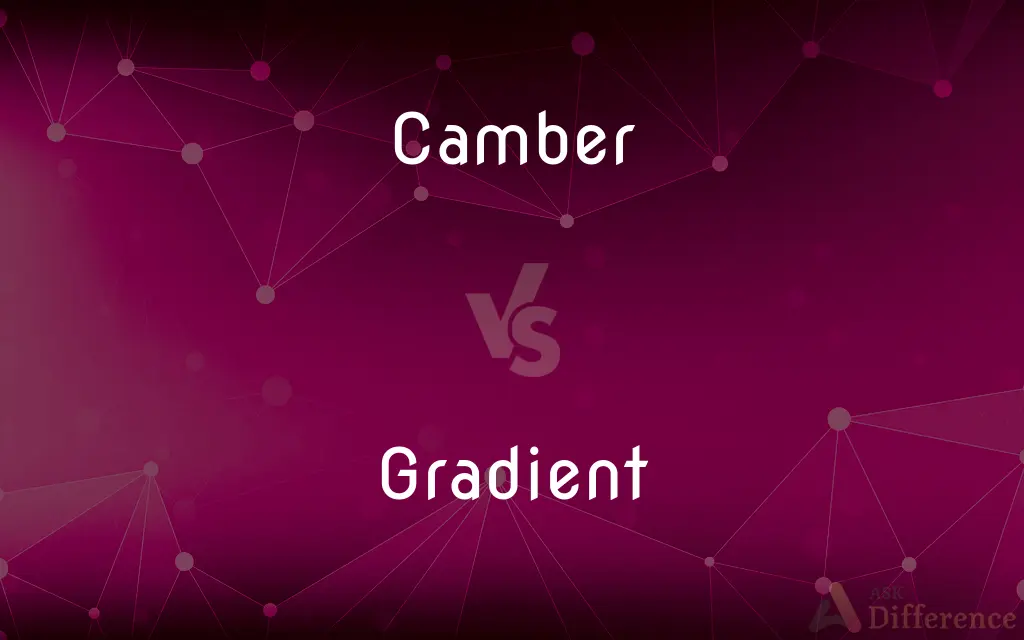Camber vs. Gradient — What's the Difference?
By Maham Liaqat & Urooj Arif — Updated on April 16, 2024
Camber refers to the curvature of a road or track, aiding in water drainage and vehicle stability; gradient indicates the steepness or incline of a slope, measured as a ratio or percentage.

Difference Between Camber and Gradient
Table of Contents
ADVERTISEMENT
Key Differences
Camber in road engineering refers to the slightly arched shape of the road surface which helps in drainage and safety. On the other hand, gradient describes the angle at which a road or surface inclines from the horizontal, influencing how steep a hill or road feels when traversed.
Camber ensures that water does not pool on the roadway by allowing it to run off to the sides, thereby reducing the risk of vehicles hydroplaning during wet conditions. Whereas, gradient primarily affects the ease or difficulty of travel, impacting vehicle speed, fuel efficiency, and engine strain.
In racetracks, camber can be engineered into turns to improve the speed and stability of vehicles passing through. Conversely, gradient in such contexts might refer to changes in elevation along the track, affecting acceleration and braking dynamics.
Camber is typically expressed in degrees, describing the angle of the slope from the center to the edge of the roadway. Gradient, however, is usually denoted as a percentage or ratio, indicating the vertical rise per unit of horizontal distance.
While camber contributes to safer and more efficient vehicle handling in various weather conditions, gradient determines the physical effort required to ascend or descend a path, influencing everything from walking on a footpath to driving up a mountain road.
ADVERTISEMENT
Comparison Chart
Definition
Curvature designed into roads for drainage
Slope describing the steepness of an incline
Measurement
Typically in degrees (angle)
Usually as a percentage or ratio (rise/run)
Primary Function
Enhances drainage and vehicle stability
Measures difficulty and accessibility of slopes
Impact on Vehicles
Affects lateral stability on turns
Affects speed, fuel efficiency, and engine load
Common Use
Roads, racetracks
Roads, hills, construction projects
Compare with Definitions
Camber
Curvature of a road surface.
The camber of the highway helps in effective water drainage.
Gradient
Rate of rise or descent relative to horizontal distance.
The gradient of the old railway is quite gentle.
Camber
Tilt created by raising one side of a surface.
Camber adjustments in racing cars tailor handling characteristics.
Gradient
Mathematical measure of slope steepness.
Engineers calculated the gradient to ensure safe construction standards.
Camber
In aviation, the curvature of an airplane wing.
Wing camber contributes to the aircraft’s lift and aerodynamics.
Gradient
Increase in a variable quantity.
The temperature gradient affects how quickly the snow melts.
Camber
In optics, the curvature of a lens.
Lens camber affects how light is focused.
Gradient
Variation in grade or quality.
There’s a gradient in educational attainment across the region.
Camber
An arching or bowing as a design feature.
Bridge designs often include camber for structural reasons.
Gradient
Incline or slope of a surface.
The road's gradient makes it a challenging climb.
Camber
A slightly arched surface, as of a road, a ship's deck, an airfoil, or a ski.
Gradient
In vector calculus, the gradient of a scalar-valued differentiable function f of several variables is the vector field (or vector-valued function) ∇ f {\displaystyle \nabla f} whose value at a point p {\displaystyle p} is the vector whose components are the partial derivatives of f {\displaystyle f} at p {\displaystyle p} . That is, for f : R n → R {\displaystyle f\colon \mathbb {R} ^{n}\to \mathbb {R} } , its gradient ∇ f : R n → R n {\displaystyle \nabla f\colon \mathbb {R} ^{n}\to \mathbb {R} ^{n}} is defined at the point p = ( x 1 , … , x n ) {\displaystyle p=(x_{1},\ldots ,x_{n})} in n-dimensional space as the vector: ∇ f ( p ) = [ ∂ f ∂ x 1 ( p ) ⋮ ∂ f ∂ x n ( p ) ] .
Camber
The condition of having an arched surface.
Gradient
A rate of inclination; a slope.
Camber
A setting of automobile wheels in which they are closer together at the bottom than at the top.
Gradient
An ascending or descending part; an incline.
Camber
To arch or cause to arch slightly.
Gradient
(Physics) The rate at which a physical quantity, such as temperature or pressure, changes in response to changes in a given variable, especially distance.
Camber
A slight convexity, arching or curvature of a surface of a road, beam, roof, ship's deck etc., so that liquids will flow off the sides.
Gradient
(Mathematics) A vector having coordinate components that are the partial derivatives of a function with respect to its variables.
Camber
The slope of a curved road created to minimize the effect of centrifugal force.
Gradient
(Biology) A series of progressively increasing or decreasing differences in the growth rate, metabolism, or physiological activity of a cell, organ, or organism.
Camber
(architecture) An upward concavity in the underside of a beam, girder, or lintel; also, a slight upward concavity in a straight arch.
Gradient
A slope or incline.
Camber
(automotive) The alignment on the roll axis of the wheels of a road vehicle, where positive camber signifies that the wheels are closer together at the bottom than the top.
Gradient
A rate of inclination or declination of a slope.
Camber
(aviation) The curvature of an airfoil.
Gradient
The ratio of the rates of change of a dependent variable and an independent variable, the slope of a curve's tangent.
Camber
(nautical) A small enclosed dock in which timber for masts (etc.) is kept to weather.
Gradient
(science) The rate at which a physical quantity increases or decreases relative to change in a given variable, especially distance.
Camber
To curve upwards in the middle.
Gradient
A differential operator that maps each point of a scalar field to a vector pointed in the direction of the greatest rate of change of the scalar. Notation for a scalar field φ: ∇φ
Camber
To adjust the camber of the wheels of a vehicle.
Because he cambered the tires too much, he had less control on the turns.
Gradient
A gradual change in color. A color gradient; gradation.
Camber
An upward convexity of a deck or other surface; as, she has a high camber (said of a vessel having an unusual convexity of deck).
Gradient
Moving by steps; walking.
Camber
An upward concavity in the under side of a beam, girder, or lintel; also, a slight upward concavity in a straight arch. See Hogback.
Gradient
Rising or descending by regular degrees of inclination.
The gradient line of a railroad
Camber
To cut bend to an upward curve; to construct, as a deck, with an upward curve.
Gradient
Adapted for walking, as the feet of certain birds.
Camber
To curve upward.
Gradient
Moving by steps; walking; as, gradient automata.
Camber
A slight convexity (as of the surface of a road)
Gradient
Rising or descending by regular degrees of inclination; as, the gradient line of a railroad.
Camber
A slope in the turn of a road or track; the outside is higher than the inside in order to reduce the effects of centrifugal force
Gradient
Adapted for walking, as the feet of certain birds.
Camber
The alignment of the wheels of a motor vehicle closer together at the bottom than at the top
Gradient
The rate of regular or graded ascent or descent in a road; grade.
Camber
Curve upward in the middle
Gradient
A part of a road which slopes upward or downward; a portion of a way not level; a grade.
Gradient
The rate of increase or decrease of a variable magnitude, or the curve which represents it; as, a thermometric gradient.
Gradient
The variation of the concentration of a chemical substance in solution through some linear path; also called concentration gradient; - usually measured in concentration units per unit distance. Concentration gradients are created naturally, e.g. by the diffusion of a substance from a point of high concentration toward regions of lower concentration within a body of liquid; in laboratory techniques they may be made artificially.
Gradient
A graded change in the magnitude of some physical quantity or dimension
Gradient
The property possessed by a line or surface that departs from the horizontal;
A five-degree gradient
Common Curiosities
Why is camber important in racing tracks?
Camber is crucial in racing tracks to maintain high speeds safely by aiding vehicles in maintaining better contact with the road during turns.
How are camber and gradient measured?
Camber is generally measured in degrees, indicating the tilt or arch of a surface. Gradient is measured as a ratio or percentage indicating the rise over run.
Is camber adjustable in vehicles?
Yes, in many vehicles, especially performance and racing cars, camber can be adjusted to alter handling characteristics.
How is gradient different from camber?
Gradient refers to the steepness of a slope, often measured in percentages or as a ratio, whereas camber is about the curvature for drainage and stability.
How does camber contribute to road safety?
By ensuring proper water drainage and maintaining tire contact with the road, camber significantly enhances road safety.
What is camber in road construction?
Camber in road construction is the arch-like curvature designed into the road surface to facilitate water drainage and enhance vehicle safety.
Can gradient affect driving safety?
Yes, steeper gradients can challenge vehicle control and engine performance, especially in adverse weather conditions.
What impact does camber have on pedestrian pathways?
Camber in pedestrian pathways helps prevent water accumulation, which can make walking surfaces slippery.
What does a negative gradient indicate?
A negative gradient indicates a slope going downwards in the direction of travel.
Does gradient apply to non-vehicular contexts?
Yes, gradient is also a critical consideration in fields like geography, architecture, and engineering for designing landscapes and structures.
Can the concept of gradient be applied in finance?
Yes, in finance, gradient can describe the rate of change in costs, profits, or other financial metrics over time.
What tools are used to measure gradient?
Instruments like inclinometers and gradient meters are typically used to measure the steepness of slopes.
Does gradient affect energy consumption in vehicles?
Yes, vehicles consume more fuel and energy when ascending steep gradients due to increased engine load.
What types of roads would have high gradients?
Mountain passes and roads leading to steep terrains typically feature high gradients to navigate the elevation changes.
How do engineers decide the appropriate camber for a road?
Engineers consider factors like rainfall, road width, and traffic type to determine the optimal camber.
Share Your Discovery

Previous Comparison
Cat vs. Tomcat
Next Comparison
Condone vs. OppositeAuthor Spotlight
Written by
Maham LiaqatCo-written by
Urooj ArifUrooj is a skilled content writer at Ask Difference, known for her exceptional ability to simplify complex topics into engaging and informative content. With a passion for research and a flair for clear, concise writing, she consistently delivers articles that resonate with our diverse audience.














































